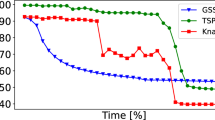Abstract
We propose a new concept for the organization of computing such that the number of sequential concurrent clock operations (or, the number of vector operations) is independent of the problem size n. Here, the architecture of the computing environment is adapted to the problem to be solved and the computing is performed without data exchange between the elementary processors the number of which depends on n. We describe an algorithm for implementing this idea using the problem of multiextremal optimization problem (the search for a maximum of n given numbers) and an algorithm for solving the traveling salesman problem as examples [1–4].
Similar content being viewed by others
References
A. Barczak, A. Tret’yakov, and L. Zakrzewski, “NP-Complete Problems and Global Computations,” in Proc. Artificial Intelligence Studies, vol. 3 ((26)) (2006).
B. A. Galkina, Discrete Mathematics: Combinatorial Optimization on Graphs (Gelios LRB, Moscow, 2003) [in Russian].
D. E. Knuth, The Art of Computer Programming, Vols. 1–3 (Addison-Wesley, Reading, Mass., 1968; Vil’yams, Moscow, 2000).
A. Tret’yakov and L. Zakrzewski, “Hybrid Intelligent Techniques for Solving Nonlinear Problems,” Scientific Bulletin of Chelm. Section of Mathematics and Computer Science. Chelm, No. 2 (2006).
G. S. Khulap and V. I. Loginov, “Application of Nonparametric Criteria for Evaluating the Quality of Communication Equations,” Izv. Vyssh. Uchebn. Zaved., Geodeziya Aerofotos“emka, No. 1 (1974).
Yu. A. Popov, A. E. Karpel’son, and G. S. Khulap, “Possibilities of Active Thermal Control of Cell Constructs,” Defektoskopiya, No. 4 (1977).
A. Tret’yakov, “The Global Calculus and the synthesis of the New Knowledge,” in The Global Calculus and the Future of Computer Science (Biala Rodlaska, 2004).
A. Tret’yakov and L. Zakrzewski, “The Algorithm of the Global Optimization Based on the Multilevel Computational Architecture,” in Proc. Artificial Intelligence Studies, Vol. 3((26)) (2006).
J. M. Ortega and W. C. Rheinboldt, Iterative Solution of Nonlinear Equations in Several Variables (Academic Press, New York, 1970; Mir, Moscow, 1975).
V. G. Karmanov, Mathematical Programming (Nauka, Moscow, 1986) [in Russian].
Author information
Authors and Affiliations
Additional information
Original Russian Text © L. Zakrzewski, A.A. Tret’yakov, G.S. Khulap, 2012, published in Izvestiya Akademii Nauk. Teoriya i Sistemy Upravleniya, 2012, No. 2, pp. 121–129.
Rights and permissions
About this article
Cite this article
Zakrzewski, L., Tret’yakov, A.A. & Khulap, G.S. A model of computer structure organization for solving global optimization problems with an algorithmic complexity that is independent of the problem size. J. Comput. Syst. Sci. Int. 51, 282–290 (2012). https://doi.org/10.1134/S1064230711060177
Received:
Accepted:
Published:
Issue Date:
DOI: https://doi.org/10.1134/S1064230711060177




